For ‘Mushroom Monday’ I managed to find another interesting species of jelly fungus growing here at Curbstone Valley, Pseudohydnum gelatinosum, also known as the ‘Toothed Jelly Fungus’.
The Toothed Jelly Fungus is widely distributed across North America and Europe, but can be rather rare, or even completely absent in some areas.
As with other jelly fungi, this species has a semi-translucent flesh with a gelatinous texture. Pseudohydnum gelatinosum is typically found growing on conifer logs or conifer debris, and this particular colony was found on a fallen Douglas Fir (Pseudotsuga menziesii) branch in the middle of our drainage canal.
The cap of this fungus species is 2-6cm across, spatulate to kidney-shaped, flat to broadly convex, and the cap margin is tucked under when young. The dorsal surface is somewhat roughly textured and may be white, tan, or brown. This species produces a white spore print.
Underneath the cap surface are numerous spines up to 5 mm in length, running down the stem. The spines are typically translucent white, but may have a bluish cast.
The tooth-like projections of this species resemble the true toothed fungi of the family Hydnaceae, hence the common name ‘Toothed Jelly Fungus’. The stem is laterally positioned in this species, but stem length varies significantly between specimens, up to 6cm.
Some reports suggest that the stem is more prominent and vertical in specimens observed on the West Coast compared to those seen in other parts of North America.
Pseudohydnum gelatinosum is reportedly edible, although most texts describe it at flavorless.


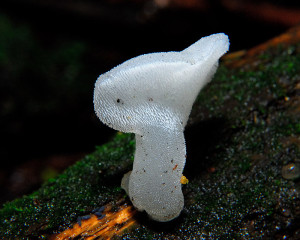

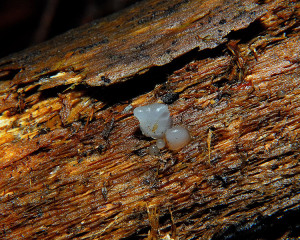
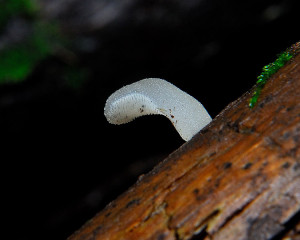
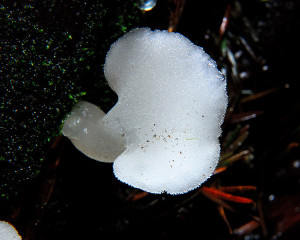
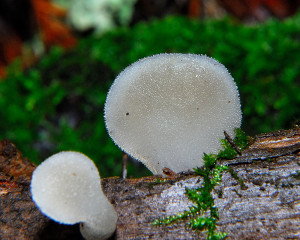

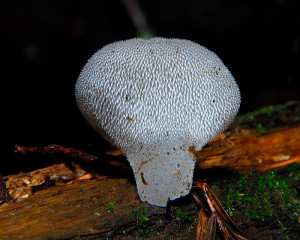
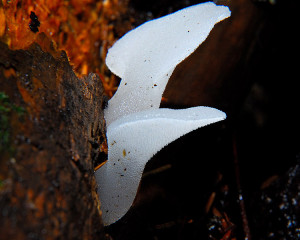







Mushroom Mondays. I like it. I’m glad you are continuing after mushroom week. That 4th photo I feel like I can actually see the thing growing. And that last is really spectacular.
I like the mushroom posts too! I’ve never seen those little guys. I’ll be on the lookout now.
This is the first colony I’d seen of these in person. I looked all around the area that I found these specimens, but couldn’t find any others. This particular Douglas Fir branch was quite decayed, as you can probably tell from a few of the photos. Certainly look out for them though on fir or pine. I’m always amazed at how quickly some of these fungi disappear. Can hardly find any ‘Redwood Rooters’ here now…but that’s a good excuse to go for a weekly mushroom walk…just to be sure I don’t miss something!
Beautiful photos – I have not paid much attention to fungi in the past, but I will be looking now.
You must have an amazingly well-trained eye to spot these things. I have some mushroom-collecting friends and am always astounded when they suddenly make a beeline to somewhere off the trail where they’ve spotted a mushroom invisible to me! Great photos.
I know next to nothing about mushrooms! And it’s a fascinating aspect of the garden/nature realm.
Looking forward to more images and thoughts from your farm, warm wishes,
Alice
Nice to see I’m not the only one on the lookout for jelly fungi this winter!
The Pseudohydnum gelatinosum (‘stekeltrilzwam’ in Dutch, could be translated as ‘thorny jelly fungus’ – because of the toothlike projections you describe) is also found in Europe, although I haven’t seen it in my garden yet (I have mostly hardwood in my garden).
Wow, that’s the craziest mushroom I’ve ever seen! Prior to this, there was an orange one that I spotted in William Umstead Park in Raleigh, NC that was the most interesting. This one wins lol.
I hate to say it, but a couple of these photos reminded me of foamy spit! These are interesting mushrooms. Now i will be looking out for unusual fungi in my yard.
“edible, but flavorless.” What kind of texture would that be in your mouth? I guess something to remember next time I’m lost in the woods!
Love the mushroom pics! I’ve been seeing all sorts of crazy-looking fungi lately. You’ve inspired me to take their pictures.